#born 1596
Explore tagged Tumblr posts
Text
#random wikipedia articles#wikipedia#pocahontas#Amonute#Makoaka#Rebecca Rolfe#a woman of many names#born 1596#died 1617#died young#Princess Makoaka#her husband presented her to English society as a civilized savage#first Native American put on a US stamp
0 notes
Text

Monica Bellucci (Italian, born Sept. 30, 1964).
Christ in the Storm on the Sea of Galilee, 1596. Jan Brueghel the Elder (Flemish, 1568-1625).
#monica bellucci#jan brueghel the elder#italian actor#italian model#fangledeities#flemish painter#baroque art#art history#sacred art#religious subjects#religious art#christian art#pinups#fashion photography#glamor photography#pin up model#jesus saves
64 notes
·
View notes
Photo

Christiaan Huygens
Christiaan Huygens (1629-1695) was a Dutch mathematician, physicist, and astronomer. A leading figure of the Scientific Revolution, Huygens combined research into mathematical-based theories, such as the movement of light waves, with practical projects, like building superior telescopes and watches using balance springs. Huygens is credited with building the first working pendulum clock and first identifying the rings of Saturn.
Early Life
Christiaan Huygens was born in The Hague, the Netherlands, on 14 April 1629. Members of his family had held senior positions in the civil service for some generations. Christiaan's father, Constantijn (1596-1687), was secretary to the leader of the Dutch Republic. Christiaan was educated privately in the family home before he moved on to the University of Leiden, where he studied law and mathematics from 1645. He did not complete his degree, but his family's wealth meant he never needed to work for a living. Free to pursue his scientific interests and encouraged to do so by his father, Huygens first concentrated on mathematics and solving problems of geometry before exploring ways to improve the instruments that astronomers relied upon for their work.
Continue reading...
38 notes
·
View notes
Text





René Descartes – Scientist of the Day
René Descartes, a French natural philosopher, was born Mar. 31, 1596. Many accounts of early modern science give Descartes short shrift, in scrambling to get from Galileo...
learn more
#Rene Descartes#geology#theories of the Earth#ToE#histsci#histSTM#17th century#history of science#Ashworth#Scientist of the Day
19 notes
·
View notes
Text



On March 10th 1615 we saw the judicial murder in Glasgow of John Ogilvie, for saying Catholic Mass and for treason.
Few figures in Scottish history have had such a varied life as John Ogilvie. Born into a respected Calvinist family in Keith, Banffshire, he died a Jesuit priest at Glasgow Cross and is today Scotland’s only acknowledged post-reformation Catholic saint.
Ogilvie was educated in mainland Europe. Exposed to the religious controversies of his day and impressed with the faith of the martyrs, he decided to become a Catholic. In 1596, aged seventeen, he was received into the Church at Louvain, Belgium.
He attended a variety of Catholic educational institutions, including the Benedictine College at Ratisbon (Regensburg) in Germany, and Jesuit houses at Olmutz (Olomouc) and Brunn (Brno) in what is now the Czech Republic. He was ordained a Jesuit priest at Paris in 1610 and repeatedly asked to be sent to Scotland. He eventually arrived in November 1613 and ministered clandestinely in the central belt to the few remaining Catholics. His missionary career however lasted less than a year when someone posing as a Catholic betrayed him.
After his arrest he was tortured in prison in an effort to get him to reveal the names of other Catholics, but he refused. Eventually, Father John Ogilvie was convicted of high treason for denying the king’s spiritual jurisdiction by upholding the Pope’s spiritual primacy. he was hanged and drawn at Glasgow Cross on 10 March 1615 aged thirty-six.
He was canonised in 1976 by Pope Paul VI following the inexplicable – later declared miraculous - cure of John Fagan, a working man from Easterhouse in Glasgow devoted to the then-Blessed John Ogilvie whose advanced cancer vanished after prayer to him. Fagan eventually died after suffering a stroke in 1993 aged 79.
12 notes
·
View notes
Text
Anne Seymour, Countess of Warwick: "Lady Warywcks Lunacye"
Following the death of her second husband Sir Edward Unton in Sep 1582, an inquest was held the following month, on 25 Oct 1582, relating to his widow Anne Seymour, Countess of Warwick's mental state.

The inquest heard how Anne had been suffering from "bouts of madness" since 1566, when she was approx 28 years old. However, at the time of the inquest, she was described as being "a lunatic enjoying lucid intervals", with her former brother-in-law Robert Dudley, 1st Earl of Leicester also writing 2 years later to William Cecil, Lord Burghley, expressing his concerns about "my Lady Warwycks Lunacye".
The inquest deemed her to be incapacitated, and subsequently granted custody of her person to her second son, Henry Unton. Anne was to continue to reside at the family's main residence of Wadley, Oxfordshire, which had also been granted to Henry in his father's will, until her death in Feb 1591. The eulogy delivered at Anne's funeral declared that “she is gone from a vale of miserie, to a haven of all happines”.
Following Henry's own death in Mar 1596, his widow Dorothy (who had been Anne's chief mourner at her own funeral 5 years previously) commissioned a memorial portrait, commemorating his heritage and multiple significant life events. Henry's Seymour ancestry was highlighted, including that of his paternal grandfather, as well as the bond shared with his mother: Anne is portrayed as a loving and attentive mother to the infant Henry, who is depicted lying contently in her arms.
#tudor england#tudor history#history#tudor people#tudor#tudors#tudor women#anne seymour#Robert dudley#mental illness#mental health#tudor health#sir Henry unton#faringdon
7 notes
·
View notes
Text
I'm doing that thing where I obsess and make timelines, and I'm doing that for JJK rn. As I'm calculating everything, I'm finding so much shit that makes sense together. I can't believe it.

1596 - 1615 Keichō era (422-403 years ago) Head of the Gojo clan with the Limitless and Six Eyes and head of the Zen'in clan with the Ten Shadows Technique, killed each other in front of the aristocracy. Likely, this was the last Six Eyes holder to be born until approx. 400 years later, when Satoru Gojo is born.

The Gojo family, who passes down the Limitless Cursed Technique, acquired the "Six Eyes" for the first time in approximately 400 years, with the possession of the current head— Gojo Satoru, the strongest sorcerer of the modern era.
Gege you mad lad. This stuff actually FITS together! What the hell!



Like, the last Six Eyes holder just happened to be the one who fought against a Zen'in's Ten Shadows technique??? So the next one didn't show up for over 400 years!!! And remember Megumi implied that that clan head probably used Mahoraga.

Chapter 117
Just throwing this out there... that this kind of nonchalant/negligent foreshadowing is so Gege's style. He deliberately obfuscates information and then doesn't bring it up for a dozen chapters (or more, as it is here).
Also, this smells fishy af. Did Kenjaku have something to do with the two Inherited Techniques clashing?! An experiment to see what would happen? I wouldn't be surprised, tbh.
#jjk meta#theories#kenjaku#six eyes#gojo satoru#fushiguro megumi#jjk manga#jjk spoilers#timeline#jujutsu kaisen#my jjk#let's try to be more bloggy shall we#all of this shit just coming together...#like i dont need to stretch out information to try and make sense of it#i just need to really sit down and think and they piece themselves together#only plot hole i found is nanami's age as 27 but should be 28 by the time we meet him in canon#i'll forgive u one time
110 notes
·
View notes
Text
Matoaka
Matoaka, known more widely as Pocahontas, was born into the Powhatan people around 1596. Her early years were spent in the midst of a bustling household led by her father, Chief Powhatan, in the Tsenacommacah region of Virginia. Though her given name was Amonute, she was affectionately known as Matoaka within her community. As a child, she likely engaged in the daily tasks typical of her culture, contributing to farming, gathering, and other domestic chores alongside her kin.
Her encounter with the English came in 1607 when Captain John Smith arrived at her father's capital. Despite legends suggesting her role in Smith's rescue, her involvement in saving him is debated among historians.
As tensions between the English settlers and the Powhatan people escalated, Matoaka's life took a tumultuous turn. She married a man named Kocoum, likely as a strategic move by her father to ensure her safety. However, her capture by English colonists in 1613 disrupted these plans, leading to her baptism, marriage to John Rolfe, and eventual journey to England.
In England, Matoaka was thrust into the spotlight, presented as a symbol of the "civilised savage" to garner support for the struggling Jamestown colony. Despite the attention, her time in England was marked by challenges, including strained relationships and deteriorating health.
Tragically, Matoaka's life was cut short at the age of around twenty-one, just as she prepared to return to Virginia. Her legacy, overshadowed by romanticised narratives, reveals a complex intersection of cultures and the harsh realities of early colonial America. She was not merely a figure of romance, but a young woman who suffered due to a rapidly changing world.
21 notes
·
View notes
Text

Herald of the path of salvation, true keeper of Apostolic Tradition, / unshakable pillar, teacher of piety, and expounder of Orthodoxy; / O hierarch Barsanuphios, / entreat the Master of all to grant peace to the world, / and to our souls great mercy.
Saint Barsanuphius, Bishop of Tver
Commemorated on April 11
Saint Barsanuphius of Tver was born in the year 1495, and was from Serpukhov. He was named John in Baptism, and he was taught to read and write. While still a youth, he was captured by the Crimean Tatars. Accepting this as the Lord’s will, he meekly submitted to his masters, and dutifully accomplished the work they assigned him to do. After three years, John’s father ransomed him. He then went to Moscow and became a monk in the Andronikov Monastery, where he received the monastic name Barsanuphius.
Devoting himself to the ascetical life, he became proficient in virtue and piety. In 1544, he was appointed as igumen of the Pesnosha Monastery. Later, he went to Kazan and founded a monastery dedicated to the Transfiguration of the Lord.
While in Kazan, Archimandrite Barsanuphius was able to help Saint Gurias (December 5) in spreading Christianity among the Moslems and pagans. His knowledge of the Tatar language proved to be very useful in this work.
In 1567, Saint Barsanuphius was consecrated Bishop of Tver. He healed many sick people with his knowledge of medicine, but he also healed those suffering from infirmities of the soul.
When the God-pleaser reached old age, he returned to Kazan and to the Transfiguration Monastery which he founded. There he received the Great Schema, and he died at the monastery in 1576.
The holy relics of Saints Gurias and Barsanuphius were uncovered on October 4, 1596. They were placed in shrines in a side chapel of the church at the orders of Patriarch Job. On June 20, 1630 their grace-filled relics were transferred from the Transfiguration Monastery to the Cathedral of the Annunciation.
[Text from the Orthodox Church in America]
2 notes
·
View notes
Text
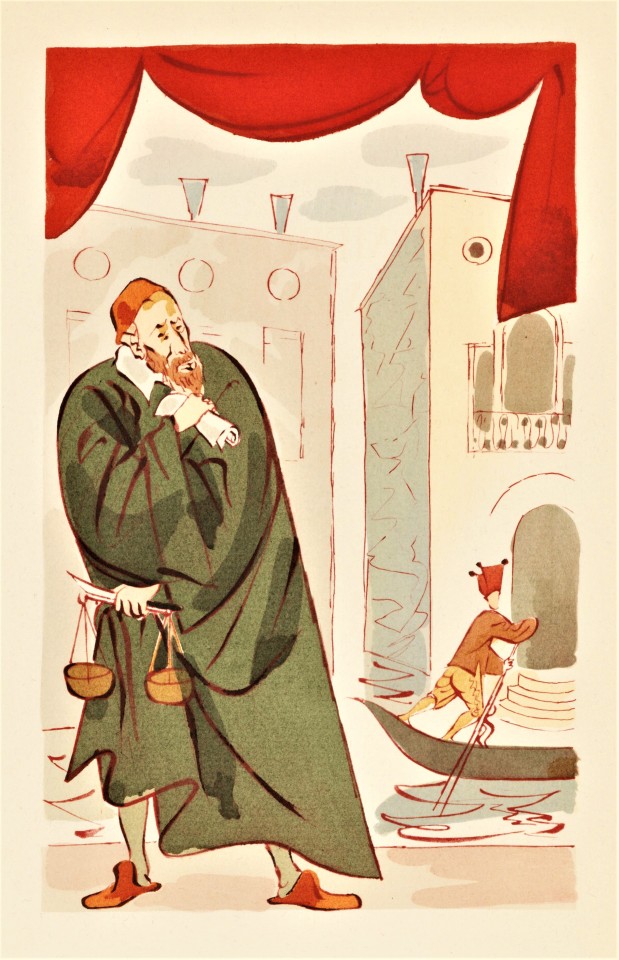
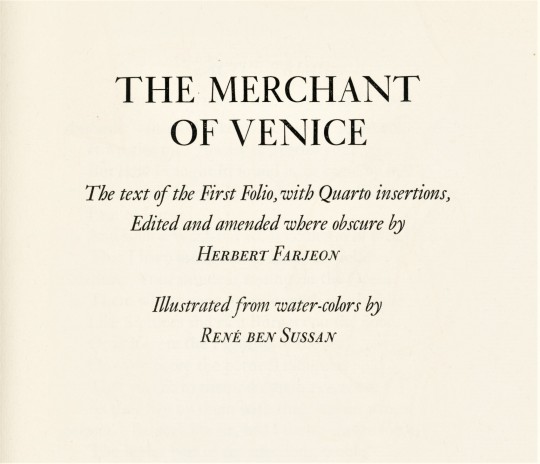

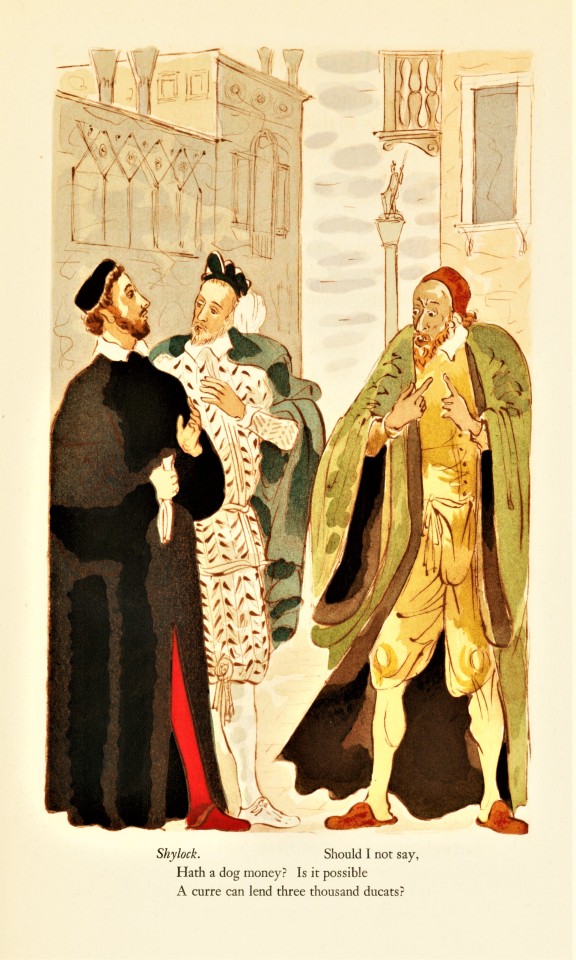
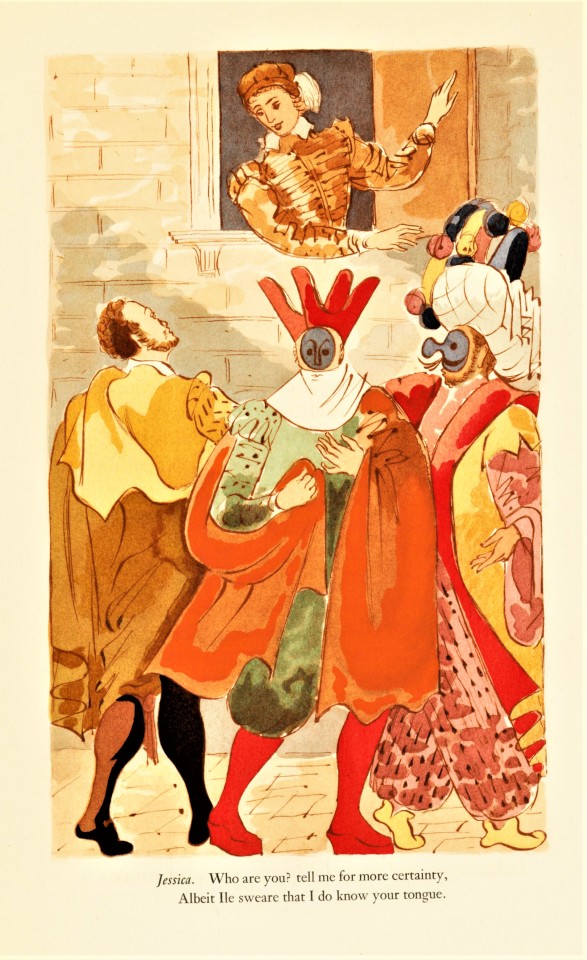



Shakespeare Weekend
William Shakespeare’s play The Merchant of Venice, is volume twenty-three of the thirty-seven volume The Comedies Histories & Tragedies of William Shakespeare, published by the Limited Editions Club (LEC) from 1939-1940. The play is believed to have been composed between 1596 and 1598, and is mentioned in Francis Meres's commonplace book in 1598. James Roberts, the printer for Shakespeare's theatre company, entered the play in the Register of the Stationers Company on July 22, 1598 and he printed the text as a quarto for the bookseller Thomas Heyes in 1600. This first edition's title page states that the play had already been acted "divers times" by the company. The Roberts/Heyes quarto became the basis of the text published in the 1623 First Folio, which adds a number of stage directions, mainly musical cues.
The LEC Merchant of Venice was illustrated with reproduced watercolors by the Greek-born French artist Rene Ben Sussan, who became a principal illustrator for LEC publications through the 1950s. In a description of the six illustrations he did for this edition, Ben Sussan writes:
The principal character in The Merchant of Venice is not Antonio, the merchant, but Shylock; therefore Shylock is portrayed on the frontispiece. . . . The plate in the first act shows the heinous figure of Shylock confronting Antonio, and Bassanio the image of perfect friendship. In the second act a merry scene of Venetian carnival and Jessica's elopement are depicted. The third illustration shows fair Portia, personifying all the beauty and intelligence of the Renaissance, and Bassanio about to choose a casket. The fourth shows the Court of Justice, the Duke surrounded by Magnificoes, Shylock and Portia in the tense contending moment of the trial. The last plate is an illustration of the garden in Belmont -- the night, the musicians, Jessica and Lorenzo express the romance, Launcelot the merriness of the epilogue.
The volumes in the set were printed in an edition of 1950 copies at the Press of A. Colish, and each was illustrated by a different artist, but the unifying factor is that all volumes were designed by famed book and type designer Bruce Rogers and edited by the British theatre professional and Shakespeare specialist Herbert Farjeon. Our copy is number 1113, the number for long-standing LEC member Austin Fredric Lutter of Waukesha, Wisconsin.
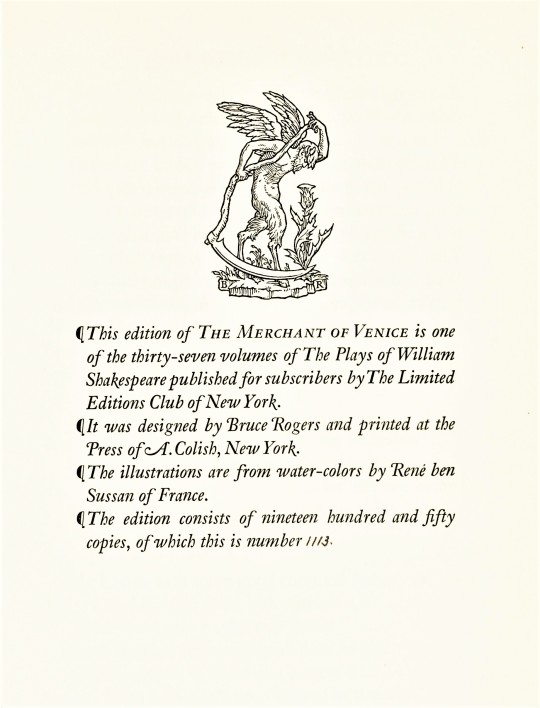
View more Limited Edition Club posts.
View more Shakespeare Weekend posts.
#Shakespeare Weekend#William Shakespeare#The Merchant of Venice#Shylock#Rene Ben Sussan#watercolors#Limited Editions Club#LEC#fine press books#bruce rogers#Herbert Farjeon#Press of A. Colish
65 notes
·
View notes
Photo

Caravaggio (Italian, 1571-1610)
Boy Bitten by a Lizard, 1594–1596
oil on canvas
@ Wikimedia Commons
Born Michelangelo Merisi, Caravaggio is the name of the artist's home town in Lombardy in northern Italy. In 1592 at the age of 21 he moved to Rome, Italy's artistic centre and an irresistible magnet for young artists keen to study its classical buildings and famous works of art. The first few years were a struggle. He specialised in still lifes of fruits and flowers, and later, half length figures (as in ‘Boy Bitten by a Lizard’) which he sold on the street...
info: https://www.nationalgallery.org.uk/artists/caravaggio
#Caravaggio#Baroque#italian art#italian renaissance#Renaissance#Michelangelo Merisi da Caravaggio#art#portrait#mu art#mu#wikimedia commons
5 notes
·
View notes
Photo

Francis Bacon
Francis Bacon (1561-1626) was an English philosopher, statesman, and author. Bacon is often considered one of the founders of modern scientific research and scientific method, even as "the father of modern science" since he proposed a new combined method of empirical experimentation and shared data collection so that humanity might finally discover all of nature's secrets and improve itself.
Political Career
Francis Bacon was born on 22 January 1561 in London. His family had powerful connections, his uncle, for example, was William Cecil, Lord Burghley (l. 1520-1598), special advisor and personal secretary to Elizabeth I of England (r. 1558-1603) from 1558 to 1572. Lord Burghley also served as Lord Treasurer from 1572 to 1598. Bacon joined the University of Cambridge in 1573. Completing his studies in law at London's Inns of Court, Bacon joined the English embassy in France, a post he held until 1584.
Returning to England, Bacon began a career in politics, which would see him reach the very top of what could be a highly dangerous tree, one particularly susceptible to brutal pruning by unpredictable absolute monarchs. Alexander Pope, known for his sharp humour, once described Bacon as "the wisest, brightest, and meanest of mankind" (Rundle, 31). Bacon was first elected a member of Parliament in 1581. His uncle's patronage failed to secure Bacon the position of Attorney-General in 1594 and 1596. Perhaps Burghley pushed too hard for his nephew since, in the end, the queen stated she would appoint anyone except Bacon to the post.
In 1596, Queen Elizabeth did appoint Bacon to the Queen's Counsel. Bacon ultimately deserted his famous uncle and sided with Burghley's great enemy, Robert Devereux, Earl of Essex (1566-1601). This was an unfortunate choice of ally since Essex soon found himself in disgrace. Fortunately, Bacon redeemed himself somewhat by helping to secure Essex's execution in 1601 and then justifying his political machinations in his Apology of 1604, where he explained that his ultimate loyalties lay neither with Burghley nor Essex but belonged, rather, to his monarch.
In 1603, Bacon was knighted by the new monarch, James I of England (r. 1603-1625). More extravagant titles followed, that of 1st Baron Verulam in 1618 and Viscount St. Albans in 1621. In 1618, the same king appointed Bacon Lord Chancellor, but he did not hold the position for long since allegations of corruption soon surfaced. Bacon admitted his guilt, was held in the Tower of London for four nights, and suffered a whopping fine of £40,000 (£8 million today). Fortunately, King James cancelled the fine, but with his political career in tatters, Bacon concentrated on his more academic pursuits. In these, he would be remarkably successful and influential, all the more surprising since he did not himself seriously practice any branch of science.
Continue reading...
15 notes
·
View notes
Text
SAINT OF THE DAY (November 12)
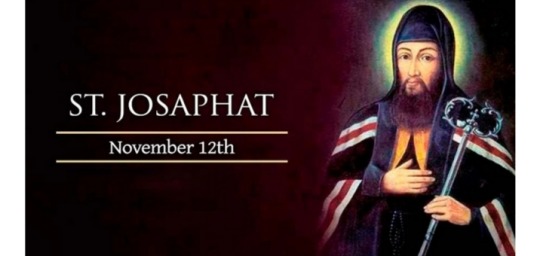
Today, on the day of his martyrdom, November 12, Roman Catholics and some Eastern Catholics remember St. Josaphat Kuntsevych, a bishop and monk whose example of faith inspired many Eastern Orthodox Christians to return to full communion with the Holy See.
Other Eastern Catholics, including the Ukrainian Catholic Church, celebrate St. Josaphat's feast day on November 25.
Born in 1580 in the western Ukrainian region of Volhynia, John Kuntsevych did not become “Josaphat” until his later life as a monk.
He was also not initially a full member of the Catholic Church, born to Orthodox Christian parents whose church had fallen out of communion with the Pope.
Although the Eastern churches began to separate from the Holy See in 1054, a union had existed for a period of time after the 15th-century Ecumenical Council of Florence.
But social, political and theological disputes caused the union to begin dissolving even before the Turkish conquest of Byzantium in 1453.
By John’s time, many Slavic Orthodox Christians had become strongly anti-Catholic.
During this time, Latin missionaries attempted to achieve reunion with the individual eastern patriarchs.
The approach was risky, sometimes politicizing the faith and leading to further divisions.
But it did yield some notable successes, including the reunion of John’s own Ruthenian Church in the 1596 Union of Brest.
John was trained as a merchant’s apprentice and could have opted for marriage.
However, he felt drawn to the rigors and spiritual depth of traditional Byzantine monasticism.
Taking the monastic name of Josaphat, he entered a Ukrainian monastery in 1604.
The young monk was taking on an ambitious task, striving to re-incorporate the Eastern Orthodox tradition with the authority of the Catholic Church in the era of its “Counter-reformation.”
Soon, as a priest, subsequently an archbishop, and ultimately a martyr, he would live and die for the union of the churches.
While rejecting the anti-Western sentiments of many of his countrymen, Josaphat also resisted any attempt to compromise the Eastern Catholic churches’ own traditions.
Recognizing the urgent pastoral needs of the people, he produced catechisms and works of apologetics, while implementing long overdue reforms of the clergy and attending to the needs of the poor.
Josaphat’s exemplary life and zeal for the care of souls won the trust of many Orthodox Christians, who saw the value of the churches’ union reflected in the archbishop‘s life and works.
Nevertheless, his mission was essentially controversial, and others were led to believe lurid stories and malicious suggestions made about him.
In 1620, opponents arranged for the consecration of a rival archbishop.
As tensions between supporters and opponents began to escalate, Josaphat lamented the onset of attacks that would lead to his death.
“You people of Vitebsk want to put me to death,” he protested.
“You make ambushes for me everywhere, in the streets, on the bridges, on the highways, and in the marketplace.
I am here among you as a shepherd, and you ought to know that I would be happy to give my life for you.”
He finally did so, on a fall day on 12 November 1623.
An Orthodox priest had been shouting insults outside the archbishop’s residence and trying to force his way inside.
Josaphat had him removed, but the man assembled a mob in the town.
They arrived and demanded the archbishop’s life, threatening his companions and servants.
Unable to escape, Josaphat died praying for the men who shot and then beheaded him before dumping his body in a river.
Josaphat’s body was discovered incorrupt, five years later.
Remarkably, the saint’s onetime rival - the Orthodox Archbishop Meletius - was reconciled with the Catholic Church in later years.
Josaphat was beatified by Pope Urban VIII on 16 May 1643. He was canonized by Pope Pius IX on 29 June 1867.
He was the first saint of the Eastern Church to be canonized by Rome. He is the patron saint of Ukraine.
3 notes
·
View notes
Text


On November 7th 1619 Elizabeth Stuart was crowned Queen of Bohemia.
Elizabeth was the eldest daughter of James VI, and Anne of Denmark. She was thus sister to King Charles I and cousin to King Frederick III of Denmark.
Born in at Falkland Palace, Fife,on 19th August 1596, she was named Elizabeth in honour of the then-ageing English Queen, Elizabeth I, who had remained childless. Her older brothel was Prince Henry, of her other siblings, Charles would however go on to inherit the throne.
To all intents and purposes, Elizabeth had a happy upbringing at Linlithgow Palace, one of the grandest of Scotland’s royal residences, and one of my favourite places to wander around.
In 1603 her father James succeeded Elizabeth I to the English throne. Elizabeth was handed over to the care of Lord and Lady Harrington and took up residence at Coombe Abbey, Warwickshire.
Lord Harrington indulged her passion for nature, and in a secluded wilderness at the end of the park arranged the construction of a number of little wooden buildings in all the different orders of architecture which housed paintings and stuffed animals. He also established an aviary and a miniature menagerie (she continued to collect various animals throughout her life) which was later expanded to include meadows stocked with the smallest breeds of cattle from Jersey, Shetland and the Isle of Man. Elizabeth referred to her miniature world as ‘her Territories’ and ‘her Fairy farm’ and she engaged a pauper family as keeper of her birds and beasts.
Elizabeth idolised her older brother - they shared a love of life which eluded the sickly Charles, four years younger than his sister. Her letters to her brother Henry reveal a deep affection and and mutual respect. In 1605 she writes ‘My noble brother, I rouse you from sleep to remind you that I am your most humble servant, and desire above all that I might have the pleasure of remaining in your good graces and your best loved sister.’
Henry’s sickness and death on November 6, 1612, in the midst of Elizabeth's betrothal celebrations devastated her. It is not mentioned in Elizabeth’s letters of 1612 or 1613, a silence that suggest great mourning however her strength of character can be demonstrated by her attempts to gain access to Henry’s isolated sick room. Disguised as a country girl, she tried several times to gain admittance to Henry but was recognised and turned back. Henry’s last words were his sister’s name.
By the age of 12 Elizabeth’s political value was such that a member of the influential Hapsburg family, King Philip III of Spain, put himself forward as a eligible suitor. While Queen Anne relished the opportunity of a glittering Spanish throne, James’ mind was set on a Protestant:Frederick V, Prince Palatine of the Rhine in the Holy Roman Empire, frequently known as the Palsgrave.
Luckily for Elizabeth, Frederick was her own age, handsome, athletic, of a winning personality and generous. In many ways he resembled her brother Henry, with whom he developed a deep friendship. Frederick could not fail to love Elizabeth although she was initially more reserved.
On Valentine’s Day 1613, a spectacular wedding ceremony took place in the Royal Chapel at Whitehall Palace in London. At the time of their marriage, Elizabeth and her young groom Frederick V were destined to achieve international power and influence. However, by 1621, Elizabeth was in exile, destined to be remembered as the ‘The Winter Queen’, a derogatory epitaph that reflects the short duration of her rule in Bohemia, with her union with Frederick deemed a political failure.For almost two months, the young couple were feted and feasted in London before setting out on their journey to their new home in Heidelberg, in south west Germany. Elizabeth and Frederick eventually reached the Palatinate and its capital in Heidelberg situated on the banks of the river Neckar.
Six years later, in late 1619, Frederick and Elizabeth were crowned King and Queen of Bohemia (today part of the Czech Republic) at the invitation of the Bohemia Confederacy to prevent a Catholic incumbent ascending to the throne. Barely a year after receiving the crown, the couple were defeated at the Battle of the White Mountain, and driven from their court in Prague and deprived of all their Palatine lands by the Hapsburg Holy Roman Emperor Ferdinand II, events which led to one of the longest and most destructive conflicts in human history:The Thirty Years War.
During their separations whilst Frederick was on campaign, the couple wrote to each other three or four times a week, sometimes even twice in one day. Frederick describes Elizabeth as his ‘only heart’, he ‘kisses her mouth a million times in imagination’.
Frederick died unexpectedly from the plague at Mainz while on perpetual military campaign in 1632. So long as she lived, Elizabeth’s rooms were draped in black, and in memory of Frederick special days were set apart for fasting. She later wrote ‘though I make a good show in company, yet I can never have any more contentment in this world, for God knows I had none but that which I took in his company, and he did the same in mine.’
Elizabeth lived on in the Dutch Republic for a further 30 years, in voluntary exile, returning to England in 1661, a year before her death and a year after the restoration of her nephew, Charles II.
It is through Elizabeth’s daughter, Sophie, the Hanoverians line was established.
8 notes
·
View notes
Text
HENRY CAREY, 1ST BARON HUNSDON
HENRY CAREY, 1ST BARON HUNSDON
1526-1596
Henry Carey was the son of Mary Boleyn and William Carey. Mary Boleyn was the older sister of Anne Boleyn (the second wife of King Henry VIII). Mary had been a mistress to King Henry VIII of England before he fell in love with her sister Anne. Mary married William in 1520 and the couple had two children. There were rumours that Henry Carey (and his sister Catherine) were fathered by King Henry VIII, due to their mother’s affair with him.
William Carey died in 1528 from the sweating sickness and Mary became a widow, Anne provided a pension for her. Anne and Henry VIII married in 1533 and their daughter Elizabeth was born.
Mary fell in love with the soldier and commoner, William Stafford and she married him in secret in 1535. When Anne found out about her sisters marriage she was furious and Mary was disowned by her family and banished from court. Mary struggled financially, and Anne finally caved in and helped her by sending her money. Anne was executed in 1536 for treason (Henry Carey was aged 10 when she was beheaded), and what happened to Mary at the end of her life is unknown, she died in 1543 in Essex.
In 1545, Carey married Anne Morganand and all up he had 16 children as well as children with his mistresses. When his cousin Elizabeth became Queen, he became Member of Parliament and was then knighted in 1559. His sister, Catherine became one of Queen’s favourite ladies-in-waiting. Carey owned Hunsdon House which had previously belonged to Queen Mary I of England. In 1564, Elizabeth I made him her personal bodyguard for four years and he later became Lord Chamberlain of the Household in 1585.
In 1587, Carey had an affair with Emilia Lanier the daughter of a court musician, he was 45-years older than her, during this time he paid her a pension. In 1529, Lanier, aged 23 gave birth to his child and Carey married Lanier off to her cousin (who was the Queen’s musician). Lanier gave birth to his son, who was also called Henry in 1593.
Carey died at Somerset House in 1596 and is buried at Westminster Abbey.
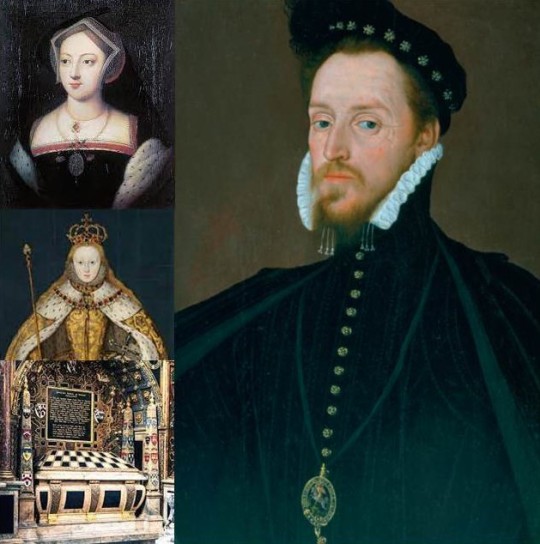
#henrycarey #henrycarey1stbaronhunsdon #anneboleyn #maryboleyn #henryVIII
7 notes
·
View notes
Text
Saints&Reading: Sunday, May 19, 2024
may 6_may 19
Tradition Liturgique: On the Third Sunday of Pascha the Orthodox Church celebrates theMyrrh-Bearing women as well as Joseph of Arimathea and Nicodimius.
SAINTS. MARY AND MARTHA, SISTERS OF ST. LAZARUS (1ST C.)

Icon: Uncut Mountain Supply
The righteous sisters Martha and Mary were believers in Christ even before He raised their brother Saint Lazarus (October 17) from the dead. After the murder of the holy Archdeacon Stephen a persecution against the Jerusalem Church broke out, and Righteous Lazarus was cast out of Jerusalem. The holy sisters then assisted their brother in the proclaiming of the Gospel in various lands.
Saints Martha and Mary are also commemorated on the Sunday of the Myrrh-bearing Women.
VENERABLE JOB, HEGUMEN OF POCHAEV AND WONDERWORKER (1651)

Saint Job, Abbot and Wonderworker of Pochaev (in the world named Ivan Zhelezo), was born around 1551 in Pokutia in Galicia. At age ten he came to the Transfiguration Ugornits monastery, and at age twelve he received monastic tonsure with the name Job. The venerable Job from his youth was known for his great piety and strict ascetic life, and he was accounted worthy of the priestly office.
Around the year 1580, at the request of the renowned champion of Orthodoxy Prince Constantine Ostrozhsky, Saint Job was appointed the head of the Exaltation of the Cross monastery near the city of Dubno, and for more than twenty years he governed the monastery amidst the growing persecution of Orthodoxy on the part of the Catholics and Uniates.
At the beginning of the seventeenth century, Saint Job withdrew to Pochaev hill and settled in a cave not far from the ancient Dormition monastery, famed for its wonderworking Pochaev Icon of the Mother of God (July 23). The holy hermit, beloved by the brethren of the monastery, was chosen as their Igumen. Saint Job zealously fulfilled his duty as head of the monastery, kind and gentle with the brethren, he did much of the work himself, planting trees in the garden, and strengthening the waterworks at the monastery.
Saint Job was an ardent defender of the Orthodox Faith against the persecution of the Catholics. Following the Union of Brest (1596), many Orthodox living in Poland were deprived of their rights, and attempts were made to force them to convert to Catholicism. Many Orthodox hierarchs became apostates to Uniatism, but Saint Job and others defended Orthodoxy by copying and disseminating Orthodox books. Prince Ostrozhsky was also responsible for the first printed edition of the Orthodox Bible (1581).
In taking an active part in the defense of Orthodoxy and the Russian people, Saint Job was present at the 1628 Kiev Council, convened against the Unia. After 1642, he accepted the great schema with the name John.
Sometimes he completely secluded himself within the cave for three days or even a whole week. The Jesus Prayer was an unceasing prayer in his heart. According to the testimony of his disciple Dositheus, and author of the Life of Saint Job, once while praying in his cave, the saint was illumined by a heavenly light. Saint Job reposed in the year 1651. He was more than 100 years old, and had directed the Pochaev monastery for more than fifty years.
The uncovering of Saint Job’s relics took place on August 28, 1659. There was a second uncovering of the relics on August 27-28, 1833.
Source: Orthodox Church in America_OCA


ACTS 6:1-7
1 Now in those days, when the number of the disciples was multiplying, there arose a complaint against the Hebrews by the Hellenists, because their widows were neglected in the daily distribution. 2 Then the twelve summoned the multitude of the disciples and said, "It is not desirable that we should leave the word of God and serve tables. 3 Therefore, brethren, seek out from among you seven men of good reputation, full of the Holy Spirit and wisdom, whom we may appoint over this business; 4 but we will give ourselves continually to prayer and to the ministry of the word. 5 And the saying pleased the whole multitude. And they chose Stephen, a man full of faith and the Holy Spirit, and Philip, Prochorus, Nicanor, Timon, Parmenas, and Nicolas, a proselyte from Antioch, 6 whom they set before the apostles; and when they had prayed, they laid hands on them. 7 Then the word of God spread, and the number of the disciples multiplied greatly in Jerusalem, and a great many of the priests were obedient to the faith.
MARK 15:43-16:8
43 Joseph of Arimathea, a prominent council member, who was himself waiting for the kingdom of God, coming and taking courage, went in to Pilate and asked for the body of Jesus. 44 Pilate marveled that He was already dead; and summoning the centurion, he asked him if He had been dead for some time. 45 So when he found out from the centurion, he granted the body to Joseph. 46 Then he bought fine linen, took Him down, and wrapped Him in the linen. And he laid Him in a tomb which had been hewn out of the rock, and rolled a stone against the door of the tomb. 47 And Mary Magdalene and Mary the mother of Joses observed where He was laid.
1 Now when the Sabbath was past, Mary Magdalene, Mary the mother of James, and Salome bought spices, that they might come and anoint Him. 2 Very early in the morning, on the first day of the week, they came to the tomb when the sun had risen. 3 And they said among themselves, "Who will roll away the stone from the door of the tomb for us?" 4 But when they looked up, they saw that the stone had been rolled away-for it was very large. 5 And entering the tomb, they saw a young man clothed in a long white robe sitting on the right side; and they were alarmed. 6 But he said to them, "Do not be alarmed. You seek Jesus of Nazareth, who was crucified. He is risen! He is not here. See the place where they laid Him. 7 But go, tell His disciples-and Peter-that He is going before you into Galilee; there you will see Him, as He said to you. 8 So they went out quickly and fled from the tomb, for they trembled and were amazed. And they said nothing to anyone, for they were afraid.
#orthodoxy#orthodoxchristianity#easternorthodoxchurch#originofchristianity#spirituality#holyscriptures#gospel#bible#wisdom#faith#saint#resurrection
5 notes
·
View notes